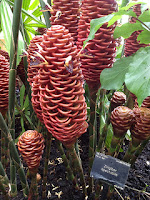We had a tour of the Palm House today, one of the few remaining greenhouses that were built with wrought iron, a revolutionary technique of its time, thanks to which the arcs of metal could span more distance.
It dates back to the 1840s, and sits next to the later Waterlily House that is managed together with it.

Besides the palms that give it its name, the collection covers the tropical rainforest, from north to south respectively: Asia, Americas & Africa (with some allowance made for the tallest plants to sit in the highest part).

At the moment a lot of emphasis is given to food crops as part of the IncrEdibles festival running this summer. We saw:
- Theobroma cacao the cocoa tree
- Coffea spp the coffee plant which has recently been in the Kew news because of its threatened status in the wild (caused by land use and climate change) and whose family, Rubiaceae, despite being one of the least well-known contains quite a few economically important plants), and
- the oil palm Elaeis sp. (did you know the oil comes from seeds?)
- bananas (Musa spp), with its dangling purple male flowers that serve more of an aesthetic purpose than anything else - as they do not often fertilise the female ones, at the top, which turn into bananas.
 |
| Pseudostem |
 |
| Flowers and bananas |
- pineapples, Ananas spp, which are very much the icon of this summer's festival
- various Zingiber, edible and non-edible ginger
 |
| Pineapple |
 |
| Non-edible Zingiber |

Back to the fascinating history of the Palm House, we learnt that it was originally heated through burning coal in the Campanile at Victoria gate, which heated water that then ran in pipes in a tunnel to the House and then through the iron grating in the floor that are still visible today.
At the extremities of the house there are benches that were originally used for potting on, but now are display areas, plants are kept in pots to remind us of their original purpose. Some of the palms in those area, you will notice, are also planted in crates, which - besides being very convenient for potting on - are the way in which plants were originally displayed in the Palm House.
I must say I did love the Waterlily House in particular, because it was so cosy and planted with more foodcrops: ones I love in my own garden, like chilli and shark fin melons. It was also really exciting to see the underside of the leaves of Victoria cruziana, the giant waterlily, which have ribs that trap air to help them float and are spiny to fend off the attacks of fish: amazing plants...





No comments:
Post a Comment